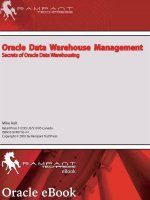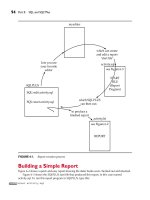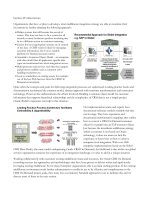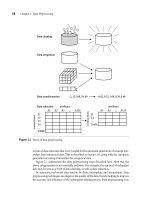Rampant TechPress Oracle Data Warehouse Management PHẦN 2 pps
Bạn đang xem bản rút gọn của tài liệu. Xem và tải ngay bản đầy đủ của tài liệu tại đây (207.93 KB, 13 trang )
ROBO B
OOKS
M
ONOGRAPH
D
ATA
W
AREHOUSING AND
O
RACLE
8
I
P
AGE
6
The major parameters for data warehouse tuning are:
SHARED_POOL_SIZE – Analyze how the pool is used and size
accordingly
SHARED_POOL_RESERVED_SIZE ditto
SHARED_POOL_MIN_ALLOC ditto
SORT_AREA_RETAINED_SIZE – Set to reduce memory usage by non-
sorting users
SORT_AREA_SIZE – Set to avoid disk sorts if possible
OPTIMIZER_PERCENT_PARALLEL – Set to 100% to maximize parallel
processing
HASH_JOIN_ENABLED – Set to TRUE
HASH_AREA_SIZE – Twice the size of SORT_AREA_SIZE
HASH_MULTIBLOCK_IO_COUNT – Increase until performance dips
BITMAP_MERGE_AREA – If you use bitmaps alot set to 3 megabytes
COMPATIBLE – Set to highest level for your version or new features
may not be available
CREATE_BITMAP_AREA_SIZE – During warehouse build, set as high
as 12 megabytes, else set to 8 megabytes.
DB_BLOCK_SIZE – Set only at db creation, can't be reset without
rebuild, set to at least 16kb.
DB_BLOCK_BUFFERS – Set as high as possible, but avoid swapping.
DB_FILE_MULTIBLOCK_READ_COUNT – Set to make the value times
DB_BLOCK_SIZE equal to or a multiple of the minimum disk read size
on your platform, usually 64 kb or 128 kb.
DB_FILES (and MAX_DATAFILES) – set MAX_DATAFILES as high as
allowed, DB_FILES to 1024 or higher.
DBWR_IO_SLAVES – Set to twice the number of CPUs or to twice the
number of disks used for the major datafiles, whichever is less.
OPEN_CURSORS – Set to at least 400-600
PROCESSES – Set to at least 128 to 256 to start, increase as needed.
RESOURCE_LIMIT – If you want to use profiles set to TRUE
ROLLBACK_SEGMENTS – Specify to expected DML processes divided
by four
C
OPYRIGHT
© 2003 R
AMPANT
T
ECH
P
RESS
. A
LL
R
IGHTS
R
ESERVED
.
ROBO B
OOKS
M
ONOGRAPH
D
ATA
W
AREHOUSING AND
O
RACLE
8
I
P
AGE
7
STAR_TRANSFORMATION_ENABLED – Set to TRUE if you are using
star or snowflake schemas.
In addition to internals tuning, you will also need to limit the users ability to do
damage by over using resources. Usually this is controlled through the use of
PROFILES, later we will discuss a new feature, RESOURCE GROUPS that also
helps control users. Important profile parameters are:
SESSIONS_PER_USER – Set to maximum DOP times 4
CPU_PER_SESSION – Determine empirically based on load
CPU_PER_CALL Ditto
IDLE_TIME – Set to whatever makes sense on your system, usually 30
(minutes)
LOGICAL_READS_PER_CALL – See CPU_PER_SESSION
LOGICAL_READS_PER_SESSION Ditto
One thing to remember about profiles is that the numerical limits they impose are
not totaled across parallel sessions (except for MAX_SESSIONS).
DM
A DM or data mart is usually equivalent to a OLAP database. DM databases are
specific use databases. A DM is usually created from a data warehouse for a
specific division or department to use for their critical reporting needs. The data
in a DM is usually summarized over a specific time period such as daily, weekly
or monthly.
DM Tuning
Tuning a DM is usually tuning for reporting. You optimize a DM for large sorts and
aggregations. You may also need to consider the use of partitions for a DM database to
speed physical access to large data sets.
Data Warehouse Concepts
Objectives:
The objectives of this section on data warehouse Concepts are to:
C
OPYRIGHT
© 2003 R
AMPANT
T
ECH
P
RESS
. A
LL
R
IGHTS
R
ESERVED
.
ROBO B
OOKS
M
ONOGRAPH
D
ATA
W
AREHOUSING AND
O
RACLE
8
I
P
AGE
8
1. Provide the student a grounding in data warehouse terminology
2. Provide the student with an understanding of data warehouse storage
structures
3. Provide the student with an understanding of data warehouse data
aggregation concepts
Data Warehouse Terminology
We have already discussed several data warehousing terms:
DSS which stands for Decision Support System
OLAP On-line Analytical Processing
DM which stands for Data Mart
Dimension – A single set of data about an item described in a fact table,
a dimension is usually a denormalized table. A dimension table holds a
key value and a numerical measurement or set of related measurements
about the fact table object. A measurement is usually a sum but could
also be an average, a mean or a variance. A dimension can have many
attributes, 50 or more is the norm, since they are denormalized
structures.
Aggregate, aggregation – This refers to the process by which data is
summarized over specific periods.
However, there are many more terms that you will need to be familiar with when
discussing a data warehouse. Let's look at these before we go on to more
advanced topics.
Bitmap – A special form of index that equates values to bits and then
stores the bits in an index. Usually smaller and faster to search than a
b*tree
Clean and Scrub – The process by which data is made ready for
insertion into a data warehouse
Cluster – A data structure in Oracle that stores the cluster key values
from several tables in the same physical blocks. This makes retrieval of
data from the tables much faster.
Cluster (2) – A set of machines usually tied together with a high speed
interconnect and sharing disk resources
C
OPYRIGHT
© 2003 R
AMPANT
T
ECH
P
RESS
. A
LL
R
IGHTS
R
ESERVED
.
ROBO B
OOKS
M
ONOGRAPH
D
ATA
W
AREHOUSING AND
O
RACLE
8
I
P
AGE
9
CUBE – CUBE enables a SELECT statement to calculate subtotals for
all possible combinations of a group of dimensions. It also calculates a
grand total. This is the set of information typically needed for all cross-
tabular reports, so CUBE can calculate a cross-tabular report with a
single SELECT statement. Like ROLLUP, CUBE is a simple extension to
the GROUP BY clause, and its syntax is also easy to learn.
Data Mining – The process of discovering data relationships that were
previously unknown.
Data Refresh – The process by which all or part of the data in the
warehouse is replaced.
Data Synchronization – Keeping data in the warehouse synchronized
with source data.
Derived data – Data that isn't sourced, but rather is derived from sourced
data such as rollups or cubes
Dimensional data warehouse – A data warehouse that makes use of the
star and snowflake schema design using fact tables and dimension
tables.
Drill down – The process by which more and more detailed information is
revealed
Fact table – The central table of a star or snowflake schema. Usually the
fact table is the collection of the key values from the dimension tables
and the base facts of the table subject. A fact table is usually normalized.
Granularity – This defines the level of aggregation in the data
warehouse. To fine a level and your users have to do repeated additional
aggregation, to course a level and the data becomes meaningless for
most users.
Legacy data – Data that is historical in nature and is usually stored offline
MPP – Massively parallel processing – Description of a computer with
many CPUs , spreads the work over many processors.
Middleware – Software that makes the interchange of data between
users and databases easier
Mission Critical – A system that if it fails effects the viability of the
company
Parallel query – A process by which a query is broken into multiple
subsets to speed execution
Partition – The process by which a large table or index is split into
multiple extents on multiple storage areas to speed processing.
C
OPYRIGHT
© 2003 R
AMPANT
T
ECH
P
RESS
. A
LL
R
IGHTS
R
ESERVED
.
ROBO B
OOKS
M
ONOGRAPH
D
ATA
W
AREHOUSING AND
O
RACLE
8
I
P
AGE
10
ROA – Return on Assets
ROI – Return on investment
Roll-up – Higher levels of aggregation
ROLLUP ROLLUP enables a SELECT statement to calculate multiple
levels of subtotals across a specified group of dimensions. It also
calculates a grand total. ROLLUP is a simple extension to the GROUP
BY clause, so its syntax is extremely easy to use. The ROLLUP
extension is highly efficient, adding minimal overhead to a query.
Snowflake – A type of data warehouse structure which uses the star
structure as a base and then normalizes the associated dimension
tables.
Sparse matrix – A data structure where every intersection is not filled
Stamp – Can be either a time stamp or a source stamp identifying when
data was created or where it came from.
Standardize – The process by which data from several sources is made
to be the same.
Star- A layout method for a schema in a data warehouse
Summarization – The process by which data is summarized to present to
DSS or DWH users.
Data Warehouse Storage Structures
Data warehouses have several basic storage structures. The structure of a
warehouse will depend on how it is to be used. If a data warehouse will be used
primarily for rollup and cube type operations it should be in the OLAP structure
using fact and dimension tables. If a DWH is primarily used for reviewing trends,
looking at standard reports and data screens then a DSS framework of
denormalized tables should be used. Unfortunately many DWH projects attempt
to make one structure fit all requirements when in fact many DWH projects
should use a synthesis of multiple structures including OLTP, OLAP and DSS.
Many data warehouse projects use STAR and SNOWFLAKE schema designs for
their basic layout. These layouts use the "FACT table Dimension tables" layout
with the SNOWFLAKE having dimension tables that are also FACT tables.
Data warehouses consume a great deal of disk resources. Make sure you
increase controllers as you increase disks to prevent IO channel saturation.
Spread Oracle DWHs across as many disk resources as possible, especially with
partitioned tables and indexes. Avoid RAID5 even though it offers great reliability
C
OPYRIGHT
© 2003 R
AMPANT
T
ECH
P
RESS
. A
LL
R
IGHTS
R
ESERVED
.
ROBO B
OOKS
M
ONOGRAPH
D
ATA
W
AREHOUSING AND
O
RACLE
8
I
P
AGE
11
it is difficult if not impossible to accurately determine file placement. The excption
may be with vendors such as EMC that provide high speed anticipatory caching.
Data Warehouse Aggregate Operations
The key item to data warehouse structure is the level of aggregation that the data
requires. In many cases there may be multiple layers, daily, weekly, monthly,
quarterly and yearly. In some cases some subset of a day may be used. The
aggregates can be as simple as a summation or be averages, variances or
means. The data is summarized as it is loaded so that users only have to retrieve
the values. The reason the summation while loading works in a data warehouse
is because the data is static in nature, therefore the aggregation doesn't change.
As new data is inserted, it is summarized for its time periods not affecting existing
data (unless further rollup is required for date summations such as daily into
weekly, weekly in to monthly and so on.)
Data Warehouse Structure
Objectives:
The objectives of this section on data warehouse structure are to:
1. Provide the student with a grounding in schema layout for data
warehouse systems
2. Discuss the benefits and problems with star, snowflake and other data
warehouse schema layouts
3. Discuss the steps to build a data warehouse
Schema Structures For Data Warehousing
FLAT
A flat database layout is a fully denormalized layout similar to what one would
expect in a DSS environment. All data available about a specified item is stored
with it even if this introduces multiple redundancies.
C
OPYRIGHT
© 2003 R
AMPANT
T
ECH
P
RESS
. A
LL
R
IGHTS
R
ESERVED
.
ROBO B
OOKS
M
ONOGRAPH
D
ATA
W
AREHOUSING AND
O
RACLE
8
I
P
AGE
12
Layout
The layout of a flat database is a set of tables that each reflects a given report or
view of the data. There is little attempt to provide primary to secondary key
relationships as each flat table is an entity unto itself.
Benefits
A flat layout generates reports very rapidly. With careful indexing a flat layout
performs excellently for a single set of functions that it has been designed to fill.
Problems
The problems with a flat layout are that joins between tables are difficult and if an
attempt is made to use the data in a way the design wasn't optimized for,
performance is terrible and results could be questionable at best.
RELATIONAL
Tried and true but not really good for data warehouses.
Layout
The relational structure is typical OLTP layout and consists of normalized
relationships using referential integrity as its cornerstone. This type of layout is
typically used in some areas of a DWH and in all OLTP systems.
Benefits
The relational model is robust for many types or queries and optimizes data
storage. However, for large reporting and for large aggregations performance
can be brutally slow.
Problems
To retrieve data for large reports, cross-tab reports or aggregations response
time can be very slow.
STAR
Twinkle twinkle
C
OPYRIGHT
© 2003 R
AMPANT
T
ECH
P
RESS
. A
LL
R
IGHTS
R
ESERVED
.
ROBO B
OOKS
M
ONOGRAPH
D
ATA
W
AREHOUSING AND
O
RACLE
8
I
P
AGE
13
Layout
The layout for a star structure consists of a central fact table that has multiple
dimension tables that radiate out in a star pattern. The relationships are generally
maintained using primary-secondary keys in Oracle and this is a requirement for
using the STAR QUERY optimization in the cost based optimizer. Generally the
fact tables are normalized while the dimension tables are denormalized or flat in
nature. The fact table contains the constant facts about the object and the keys
relating to the dimension tables while the dimension tables contain the time
variant data and summations. Data warehouse and OLAP databases usually use
the start or snowflake layouts.
Benefits
For specific types of queries used in data warehouses and OLAP systems the
star schema layout is the most efficient.
Problems
Data loading can be quite complex.
SNOWFLAKE
As its name implies the general layout if you squint your eyes a bit, is like a
snowflake.
Layout
You can consider a snowflake schema a star schema on steroids. Essentially
you have fact tables that relate to dimension tables that may also be fact tables
that relate to dimension tables, etc. The relationships are generally maintained
using primary-secondary keys in Oracle and this is a requirement for using the
STAR QUERY optimization in the cost based optimizer. Generally the fact tables
are normalized while the dimension tables are denormalized or flat in nature. The
fact table contains the constant facts about the object and the keys relating to the
dimension tables while the dimension tables contain the time variant data and
summations. Data warehouses and OLAP databases usually use the snowflake
or star schemas.
Benefits
Like star queries the data in a snowflake schema can be readily accessed. The
addition of the ability to add dimension tables to the ends of the star make for
easier drill down into a complex data sets.
C
OPYRIGHT
© 2003 R
AMPANT
T
ECH
P
RESS
. A
LL
R
IGHTS
R
ESERVED
.
ROBO B
OOKS
M
ONOGRAPH
D
ATA
W
AREHOUSING AND
O
RACLE
8
I
P
AGE
14
Problems
Like a star schema the data loading into a snowflake schema can be very
complex.
OBJECT
The new kid on the block, but I predict big things in data warehousing for it
Layout
An object database layout is similar to a star schema with the exception that
entire star is loaded into a single object using varrays and nested tables. A
snowflake is created by using REF values across multiple objects.
Benefits
Retrieval can be very fast since all data is prejoined.
Problems
Pure objects cannot be partitioned as yet, so size and efficiency are limited
unless a relational/object mix is used.
C
OPYRIGHT
© 2003 R
AMPANT
T
ECH
P
RESS
. A
LL
R
IGHTS
R
ESERVED
.
ROBO B
OOKS
M
ONOGRAPH
D
ATA
W
AREHOUSING AND
O
RACLE
8
I
P
AGE
15
Oracle and Data Warehousing
Hour 2:
Oracle7 Features
Objectives:
The objectives for this section on Oracle7 features are to:
1. Identify to the student the Oracle7 data warehouse related features
2. Discuss the limited parallel operations available in Oracle7
3. Discuss the use of partitioned views
4. Discuss multi-threaded server and its application to the data warehouse
5. Discuss high-speed loading techniques available in Oracle7
Oracle7 Data Warehouse related Features
Use of Partitioned Views
In late Oracle7 releases the concept of partitioned views was introduced. A
partitioned view consists of several tables, identical except for name, joined
through a view. A partition view is a view that for performance reasons brings
together several tables to behave as one.
The effect is as though a single table were divided into multiple tables (partitions)
that could be independently accessed. Each partition contains some subset of
the values in the view, typically a range of values in some column. Among the
advantages of partition views are the following:
C
OPYRIGHT
© 2003 R
AMPANT
T
ECH
P
RESS
. A
LL
R
IGHTS
R
ESERVED
.
ROBO B
OOKS
M
ONOGRAPH
D
ATA
W
AREHOUSING AND
O
RACLE
8
I
P
AGE
16
Each table in the view is separately indexed, and all indexes can be
scanned in parallel.
If Oracle can tell by the definition of a partition that it can produce no
rows to satisfy a query,
Oracle will save time by not examining that partition.
The partitions can be as sophisticated as can be expressed in CHECK
constraints.
If you have the parallel query option, the partitions can be scanned in
parallel.
Partitions can overlap.
Among the disadvantages of partition views are the following:
They (the actual view) cannot be updated. The underlying tables
however, can be updated.
They have no master index; rather each component table is separately
indexed. For this reason, they are recommended for DSS (Decision
Support Systems or "data warehousing") applications, but not for OLTP.
To create a partition view, do the following:
1. CREATE the tables that will comprise the view or ALTER existing tables
suitably.
2. Give each table a constraint that limits the values it can hold to the range
or other restriction criteria desired.
3. Create a local index on the constrained column(s) of each table.
4. Create the partition view as a series of SELECT statements whose
outputs are combined using UNION ALL. The view should select all rows
and columns from the underlying tables. For more information on
SELECT or UNION ALL, see "SELECT" .
5. If you have the parallel query option enabled, specify that the view is
parallel, so that the tables within it are accessed simultaneously when
the view is queried. There are two ways to do this:
specify "parallel" for each underlying table.
place a comment in the SELECT statement that the view contains to
give a hint of "parallel" to the Oracle optimizer.
C
OPYRIGHT
© 2003 R
AMPANT
T
ECH
P
RESS
. A
LL
R
IGHTS
R
ESERVED
.
ROBO B
OOKS
M
ONOGRAPH
D
ATA
W
AREHOUSING AND
O
RACLE
8
I
P
AGE
17
There is no special syntax required for partition views. Oracle interprets a UNION
ALL view of several tables, each of which have local indexes on the same
columns, as a partition view. To confirm that Oracle has correctly identified a
partition view, examine the output of the EXPLAIN PLAN command.
In releases prior to 7.3 use of partition views was frowned upon since the
optimizer was not able to be partition aware thus for most queries all of the
underlying tables where searched rather than just the affected tables. After 7.3
the optimizer became more parition biew friendly and this is no longer the case.
An example query to build a partition view would be:
CREATE OR REPALCE VIEW acct_payable AS
SELECT * FROM acct_pay_jan99
UNION_ALL
SELECT * FROM acct_pay_feb99
UNION_ALL
SELECT * FROM acct_pay_mar99
UNION_ALL
SELECT * FROM acct_pay_apr99
UNION_ALL
SELECT * FROM acct_pay_may99
UNION_ALL
SELECT * FROM acct_pay_jun99
UNION_ALL
SELECT * FROM acct_pay_jul99
UNION_ALL
SELECT * FROM acct_pay_aug99
UNION_ALL
SELECT * FROM acct_pay_sep99
UNION_ALL
SELECT * FROM acct_pay_oct99
UNION_ALL
SELECT * FROM acct_pay_nov99
UNION_ALL
SELECT * FROM acct_pay_dec99;
A select from the view using a range such as:
SELECT * FROM account_payables
WHERE payment_date BETWEEN '1-jan-1999' AND '1-mar-1999';
Would be resolved by querying the table acct_pay_jan99 and acct_pay_feb99
only in versions after 7.3. Of course if you are in Oracle8 true partitioned tables
should be used instead.
Use of Oracle Parallel Query Option
The Parallel Query Option (PQ)) should not be confused with the shared
database or parallel database option (Oracle parallel server – OPS). Parallel
C
OPYRIGHT
© 2003 R
AMPANT
T
ECH
P
RESS
. A
LL
R
IGHTS
R
ESERVED
.
ROBO B
OOKS
M
ONOGRAPH
D
ATA
W
AREHOUSING AND
O
RACLE
8
I
P
AGE
18
query server relates to parallel query and DDL operations while parallel or shared
database relates to multiple instances using the same central database files.
Due to the size of tables in most data warehouses, the datafiles in which the
tables reside cannot be made large enough to hold a complete table. This means
multiple datafiles must be used, sometimes, multiple disks as well. These huge
file sized result in extremely lengthy query times if the queries are perfomed in
serial. Oracle provides for the oracle parallel query option to allow this multi-
datafile or multi-disk configuration to work for, instead of against you. In parallel
query a query is broken into multiple sub-queries that are issued to as many
query processes as are configured and available. The net effect of increasing the
number of query servers acting on your befalf in a query is that while the serial
time remains the same, the time is broken into multiple simultaneous intervals
thus reducing the overall time spent doing a large query or operation to X/N
where X is the original time in serial mode and N is the number of query
processes. In reality the time is always greater than X/N because of processing
overhead after the query slave processes return the results and the query slaves
responsible for sorting and grouping do their work.
The use of parallel table and index builds also speeds data loading but
remember that N extents will be created where N is equal to the number of
slaves acting on the build request and each will require an initial extent to work in
temporarily. Once the slaves complete the work on each table or index extent the
extents are merged and any unused space is returned to the tablespace.
To use parallel query the table must be created or altered to have a degree of
parallel set. In Oracle7 the syntax for the parallel option on a table creation is:
CREATE TABLE table_name (column_list)
Storage_options
Table_optins
NOPARALLEL|PARALLEL(DEGREE n|DEFAULT)
If a table is created as parallel or is altered to be parallel then any index created
on that table will be created in parallel even though the index will not itself be a
parallel capable index.
If default is specified for the degree of parallel, the value for DEGREE will be
determined from the number of CPUs and/or the number of devices holding the
table's extents.
Oracle7 Parallel Query Server is configured using the following initialization
parameters:
C
OPYRIGHT
© 2003 R
AMPANT
T
ECH
P
RESS
. A
LL
R
IGHTS
R
ESERVED
.









